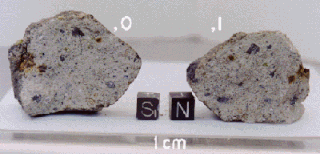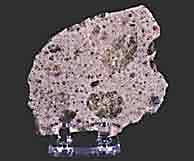Related Research Articles

A meteorite is a rock that originated in outer space and has fallen to the surface of a planet or moon. When the original object enters the atmosphere, various factors such as friction, pressure, and chemical interactions with the atmospheric gases cause it to heat up and radiate energy. It then becomes a meteor and forms a fireball, also known as a shooting star; astronomers call the brightest examples "bolides". Once it settles on the larger body's surface, the meteor becomes a meteorite. Meteorites vary greatly in size. For geologists, a bolide is a meteorite large enough to create an impact crater.

Basalt is an aphanitic (fine-grained) extrusive igneous rock formed from the rapid cooling of low-viscosity lava rich in magnesium and iron exposed at or very near the surface of a rocky planet or moon. More than 90% of all volcanic rock on Earth is basalt. Rapid-cooling, fine-grained basalt is chemically equivalent to slow-cooling, coarse-grained gabbro. The eruption of basalt lava is observed by geologists at about 20 volcanoes per year. Basalt is also an important rock type on other planetary bodies in the Solar System. For example, the bulk of the plains of Venus, which cover ~80% of the surface, are basaltic; the lunar maria are plains of flood-basaltic lava flows; and basalt is a common rock on the surface of Mars.

Vesta is one of the largest objects in the asteroid belt, with a mean diameter of 525 kilometres (326 mi). It was discovered by the German astronomer Heinrich Wilhelm Matthias Olbers on 29 March 1807 and is named after Vesta, the virgin goddess of home and hearth from Roman mythology.
A V-type (volcanic-type) asteroid, or Vestoid, is an asteroid whose spectral type is that of 4 Vesta. Approximately 6% of main-belt asteroids are vestoids, with Vesta being by far the largest of them. They are relatively bright, and rather similar to the more common S-type asteroid, which are also made up of stony irons and ordinary chondrites, with V-types containing more pyroxene than S-types.

In planetary science, planetary differentiation is the process by which the chemical elements of a planetary body accumulate in different areas of that body, due to their physical or chemical behavior. The process of planetary differentiation is mediated by partial melting with heat from radioactive isotope decay and planetary accretion. Planetary differentiation has occurred on planets, dwarf planets, the asteroid 4 Vesta, and natural satellites.

A xenolith is a rock fragment that becomes enveloped in a larger rock during the latter's development and solidification. In geology, the term xenolith is almost exclusively used to describe inclusions in igneous rock entrained during magma ascent, emplacement and eruption. Xenoliths may be engulfed along the margins of a magma chamber, torn loose from the walls of an erupting lava conduit or explosive diatreme or picked up along the base of a flowing body of lava on the Earth's surface. A xenocryst is an individual foreign crystal included within an igneous body. Examples of xenocrysts are quartz crystals in a silica-deficient lava and diamonds within kimberlite diatremes. Xenoliths can be non-uniform within individual locations, even in areas which are spatially limited, e.g. rhyolite-dominated lava of Niijima volcano (Japan) contains two types of gabbroic xenoliths which are of different origin - they were formed in different temperature and pressure conditions.
3494 Purple Mountain, provisional designation 1980 XW, is a bright Vestian asteroid and a formerly lost minor planet from the inner regions of the asteroid belt, approximately 6.5 kilometers in diameter. First observed in 1962, it was officially discovered on 7 December 1980, by Chinese astronomers at the Purple Mountain Observatory in Nanking, China, and later named in honor of the discovering observatory. The V-type asteroid has a rotation period of 5.9 hours.

An achondrite is a stony meteorite that does not contain chondrules. It consists of material similar to terrestrial basalts or plutonic rocks and has been differentiated and reprocessed to a lesser or greater degree due to melting and recrystallization on or within meteorite parent bodies. As a result, achondrites have distinct textures and mineralogies indicative of igneous processes.

HED meteorites are a clan (subgroup) of achondrite meteorites. HED stands for "howardite–eucrite–diogenite". These achondrites came from a differentiated parent body and experienced extensive igneous processing not much different from the magmatic rocks found on Earth and for this reason they closely resemble terrestrial igneous rocks.

Eucrites are achondritic stony meteorites, many of which originate from the surface of the asteroid 4 Vesta and are part of the HED meteorite clan. They are the most common achondrite group with over 100 meteorites found.

Diogenites are a group of the HED meteorite clan, a type of achondritic stony meteorites.

The Tagish Lake meteorite fell at 16:43 UTC on 18 January 2000 in the Tagish Lake area in northwestern British Columbia, Canada.

Extraterrestrial material refers to natural objects now on Earth that originated in outer space. Such materials include cosmic dust and meteorites, as well as samples brought to Earth by sample return missions from the Moon, asteroids and comets, as well as solar wind particles.

Angrites are a rare group of achondrites consisting mostly of Al-Ti bearing diopside, hedenbergite, olivine, anorthite and troilite with minor traces of phosphate and metals. The group is named for the Angra dos Reis meteorite. They are the oldest igneous rocks, with crystallization ages of around 4.56 billion years. Angrites are subdivided into two main groups, the quenched and plutonic angrites. The quenched angrites cooled rapidly upon the surface of the angrite parent body (APB), whereas the plutonic angrites cooled slower, deeper in the crust. The APB is thought to have been a similar size to the asteroid 4 Vesta.
This is a glossary of terms used in meteoritics, the science of meteorites.

Northwest Africa 7325, also known as NWA 7325, is a unique igneous meteorite which crystallized as a basalt on a large asteroid or planetesimal approximately 4.56 billion years ago. It is classified as an ungrouped achondrite, and is notable for its green fusion crust and high-magnesium/low-iron composition. It was purchased from anonymous finders in a marketplace in Erfoud, Morocco in April 2012. The original find was composed of 35 fragments with a combined weight of approximately 345 grams (12.2 oz), however many additional fragments with a total weight of over 1,100 grams (39 oz) were subsequently recovered.

The Desert Fireball Network (DFN) is a network of cameras in Australia. It is designed to track meteoroids entering the atmosphere, and aid in recovering meteorites. It currently operates 50 autonomous cameras, spread across Western and South Australia, including Nullarbor plain, WA wheatbelt, and South Australian desert, covering an area of 2.5 million km2. The locations of the stations were chosen to facilitate meteorite searching. Starting in 2018, cameras deployed across the world began the first global fireball observatory in association with partner research teams.
Mason Gully is an ordinary chondrite of subclass H5, and is the second meteorite to be recovered using the Desert Fireball Network (DFN) camera observatory. One stone weighing 24.5g was observed to fall by the Desert Fireball Network observatory in Western Australia on 13 April 2010 at 10h36m10s UTC. It was recovered by the DFN on 3 November 2010 by Dr. R. Merle and the Fireball network recovery team, and was found 150m from its predicted fall location based upon the observed trajectory and calculated mass.
Asteroidal water is water or water precursor deposits such as hydroxide (OH−) that exist in asteroids. The "snow line" of the Solar System lies outside of the main asteroid belt, and the majority of water is expected in minor planets. Nevertheless, a significant amount of water is also found inside the snow line, including in near-earth objects (NEOs).
CM chondrites are a group of chondritic meteorites which resemble their type specimen, the Mighei meteorite. The CM is the most commonly recovered group of the 'carbonaceous chondrite' class of meteorites, though all are rarer in collections than ordinary chondrites.
References
- ↑ Mittlefehldt, David W.; McCoy, Timothy J.; Goodrich, Cyrena Anne; Kracher, Alfred (1998). "Non-chondritic Meteorites from Asteroidal Bodies". Reviews in Mineralogy and Geochemistry. 36 (1): 4.1–4.195.
- 1 2 "Meteoritical Bulletin: Recommended classifications". www.lpi.usra.edu. Retrieved 2017-05-09.
- 1 2 3 4 5 "Meteoritical Bulletin: Entry for Bunburra Rockhole". www.lpi.usra.edu. Retrieved 2017-05-09.
- ↑ Takeda, Hiroshi (1997). "Mineralogical records of early planetary processes on the howardite, eucrite, diogenite parent body with reference to Vesta". Meteoritics & Planetary Science. 32 (6): 841–853. Bibcode:1997M&PS...32..841T. doi: 10.1111/j.1945-5100.1997.tb01574.x .
- 1 2 3 4 5 6 7 Bland, Philip A.; Spurný, Pavel; Towner, Martin C.; Bevan, Alex W. R.; Singleton, Andrew T.; Bottke, William F.; Greenwood, Richard C.; Chesley, Steven R.; Shrbený, Lukas (2009-09-18). "An Anomalous Basaltic Meteorite from the Innermost Main Belt". Science. 325 (5947): 1525–1527. Bibcode:2009Sci...325.1525B. doi:10.1126/science.1174787. ISSN 0036-8075. PMID 19762639. S2CID 206520476.
- ↑ Wiechert, U. H.; Halliday, A. N.; Palme, H.; Rumble, D. (2004-04-30). "Oxygen isotope evidence for rapid mixing of the HED meteorite parent body". Earth and Planetary Science Letters. 221 (1–4): 373–382. Bibcode:2004E&PSL.221..373W. CiteSeerX 10.1.1.528.4742 . doi:10.1016/S0012-821X(04)00090-1.
- 1 2 3 4 5 Benedix, G. K.; Bland, P. A.; Friedrich, J. M.; Mittlefehldt, D. W.; Sanborn, M. E.; Yin, Q. -Z.; Greenwood, R. C.; Franchi, I. A.; Bevan, A. W. R. (2017-07-01). "Bunburra Rockhole: Exploring the geology of a new differentiated asteroid" (PDF). Geochimica et Cosmochimica Acta. 208: 145–159. Bibcode:2017GeCoA.208..145B. doi:10.1016/j.gca.2017.03.030.
- ↑ Sanborn, M. E.; Yin, Q.-Z. (2014-03-01). "Chromium Isotopic Composition of the Anomalous Eucrites: An Additional Geochemical Parameter for Evaluating Their Origin". Lunar and Planetary Science Conference. 45 (1777): 2018. Bibcode:2014LPI....45.2018S.
- ↑ Hutchison, Robert (2004-09-16). Meteorites: A Petrologic, Chemical and Isotopic Synthesis. Cambridge University Press. ISBN 9780521470100.